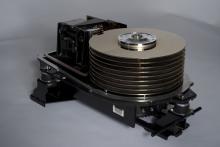
The 3390 disks rotated faster than those in the previous model 3380. Faster disk rotation reduced rotational delay (ie. the time required for the correct area of the disk surface to move to the point where data could be read or written). In the 3390's initial models, the average rotational delay was reduced to 7.1 milliseconds from 8.3 milliseconds for the 3380 family.
The data transfer rate -- the speed that data can move to and from the disk surface -- was also increased, from 3.0 megabytes per second for the 3380 family to 4.2 megabytes per second for the 3390.
This drive, which originates from around 1989, would’ve been teamed up with a number of other drives and slotted into a IBM 3390 Direct Access Storage Device (DASD) — a floor-to-ceiling server rack. One IBM 3390 model was capable of storing up to six drives, for a total capacity of 22.7GB. A complete IBM 3390 system had a data transfer rate of 4.2MB/sec, with an average seek time of 12.5 milliseconds. The platters probably span at around 2,500-3,000 RPM.
While it’s hard to put an exact price on a single drive, it would’ve cost somewhere in the region of CHF 50,000 to CHF 100,000 in 1989 — or about twice that, in today’s money. That’s around CHF 50,000 per gigabyte — or one million times more expensive than today’s hard disk drives.
For more information, see:
http://www-03.ibm.com/ibm/history/exhibits/storage/storage_3390.html
